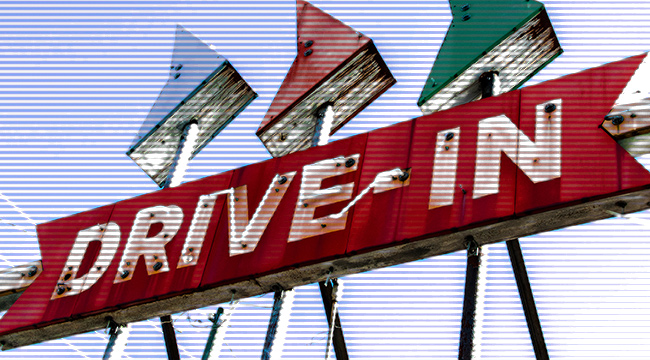
Like many outdoor movie theaters across the country, Warner’s Drive-In went dark in 2014.
The Franklin, West Virginia theater had been in operation for 62 years, built during the drive-in boom of the mid-1950s. The once-thriving institution, however, couldn’t afford the switch to digital projection. Quentin Tarantino declared that “cinema is dead,” following the demise of 35mm projection, and that was certainly the case for many outdoor theaters. Of the less than 400 drive-ins left in the U.S., the Los Angeles Times estimated in 2013 that just 10 percent were equipped for digital projection.
Making the upgrade would have cost Warner’s an exorbitant sum for a small business — between $50,000 to $100,000. Instead of going digital, its previous owners decided to close the beloved theater, a staple of life in the small Appalachian town, which is home to just 721 people.
Just two years later, Warner’s Drive-In made an unexpected comeback — and it’s not alone. The drive-in is witnessing a resurgence, with local theater owners fighting to save or restore their venues decades after the outdoor movie was pronounced dead. Franklin held a fundraiser to purchase a digital projector, selling t-shirts to pull together the necessary cash. According to Mike Mallow, the newest owner of Warner’s, the enthusiasm from the community was palpable. One townsperson even sold his house and donated the proceeds to the revitalization effort.
“It’s been part of the community since 1952,” the 35-year-old tells us. “Several generations have grown up with it — me being one of them.”
As a child, Mallow was rarely allowed to go to the movie theater. The rare exception was Disney’s The Lion King, which he saw on the big screen in 1994 after his siblings pleaded with their parents to let them see it. But as a teenager he became drawn to the community aspect of drive-ins, which combined an atmosphere akin to tailgating with his love of the cinema.
“When I got my driver’s license, I started going regularly — every weekend that I could,” Mallow says. “It’s almost like a cookout or a lawn party, where you go and talk with friends and you get to watch a movie when it gets dark. It’s a big social event before the movie.”
Warner’s isn’t the only venue being granted a second life. Drive-ins like Holiday Twin in Fort Collins, Colorado.; Electric Dusk in Los Angeles, California.; Bangor in Hermon, Maine; and Hound’s in Kings Mountain, N.C. have all reopened in recent years after periods of being shut down. Others have opened for the first time, hoping to cash-in on the increased interest in a bygone era of moviegoing.
But as drive-in owners argue, it’s not just nostalgia that’s driving the renewed interest in outdoor theaters. These institutions have a lot to offer modern moviegoers who might be seeking a happy medium between the multiplex and Netflix and chill.
The Rise And Fall Of The American Drive-In
The drive-in wasn’t originally intended to reinvent how the American public goes to the theater. It was designed as a gift for Richard M. Hollingshead Jr.’s mother. A very tall woman, she found movie theater seats to be uncomfortable. Hollingshead came up with a novel solution to his mother’s aches and pains: He made a makeshift screen out of a white sheet nailed between two trees in his backyard. Hollingshead, who worked as an auto parts salesman in his father’s company, placed a radio behind the blanket and a projector on the hood of his car.
Based on this prototype, he would open his first drive-in theater in New Jersey in 1933. Called the Camden Drive-In, its first screening was Wives Beware, a little-seen British comedy starring Adolphe Menjou. A second outdoor venue, Shankweiler’s Auto Park, would open less than a year later in Orefield, Pennsylvania. It continues to operate to this day.
Many other theaters that came of age during the drive-in boom would not be so lucky. The rise of outdoor movies was fueled by America’s great romance with the automobile, with the drive-in reaching its peak of popularity in 1958. This was the year James Stewart stalked Kim Novak in Alfred Hitchcock’s Vertigo, Rosalind Russell went from riches to rags (and back to riches again) in Auntie Mame, and Elizabeth Taylor lusted after the dreamy yet unattainable Paul Newman in Cat on a Hot Tin Roof.
The drive-in’s long-term viability, however, would be threatened by the introduction of video cassette recorders in the mid-1970s. The technology didn’t catch on with the American public until the mid-1980s, when the price of VCRs began to fall. Although a new Sony SL-7200 Beta would have set consumers back $1,000 in 1976, the average cost of a VCR fell below $400 by 1985.
Just three years later, drive-ins across the country were reporting serious financial trouble.
Speaking to the Associated Press for a 1988 piece, theater owners claimed that customers had abruptly stopped coming. Now that moviegoers didn’t have to rely on theaters for their sole source of film entertainment, drive-ins like Stanton, Kentucky’s Mountain View Drive-In recorded sparse attendance. Whereas Saturday nights used to be packed with cars, two-thirds of the lot stood empty.
“I don’t know why people aren’t coming now like they did two years ago,” David Baker, the owner of Mountain View, told the AP.
While the VCR didn’t help business, there were — in truth — a number of reasons that patrons started staying home during the 1970s and ’80s. Following the oil embargo of 1973, gas prices had increased dramatically, making the cost of a family night at the drive-in more expensive. As the suburbs continued to expand, many floundering venues were bulldozed to make room for shopping malls and subdivisions. Because drive-ins are seasonal, they weren’t seen as a lucrative use of what could be prime real estate.
In addition, film distributors increasingly began investing their energy in multiplexes, which could earn more bang for their buck. Whereas a drive-in screens just two films a night (with many running only on the weekends), your local multiplex has the capability to show a myriad of options multiple times each day. Blackballed by major studios, many outdoor theaters began to play X-rated movies to stay afloat.
At the drive-in’s apex back in 1958, outdoor venues made up 25 percent of all theaters. Today, that number is down to 1.5 percent.
The Unexpected Second Feature
Forty-six-year-old Ralph Matamoros came of age in the 1980s, just as drive-ins began to disappear across the country. “Just as I started to fall in love with the experience, they started becoming extinct,” Matamoros says. “I felt like I got cheated out of it.”
As an adult, Matamoros became a patron of the Electric Dusk Drive-In, where he says that he was drawn to the atmosphere of the classic Los Angeles venue. Once known as the Devil’s Night Drive-In, the pop-up theater was formerly located at San Julian St. in downtown L.A., adjacent to the Fashion District and Skid Row. Electric Dusk, one of just five drive-ins in the city, closed in 2015 after the lot was converted into an industrial center.
Inspired by his experiences at the theater, Matamoros took over the drive-in, which reopened this summer at the Los Angeles Community College District. The drive-in is a pop-up, with films projected onto a giant inflatable screen using a Sanyo Pro Xtrax. This means that, as long as there’s investment, the theater can be housed just about anywhere. At one point, the event took place on a rooftop.
Since reopening, the Electric Dusk has specialized in showcasing popular films from the 1980s and 90s — like Reality Bites, Pulp Fiction, and Fast Times at Ridgemont High.
According to Matamoros, business has been steadily increasing.
“Attendance was mixed at the very beginning,” he says. “We wanted a sellout and it didn’t quite happen. We did get a lot of word of mouth. The second event was better, and the third was even better than that. We are gradually moving upward. Our goal is to eventually sell out, and I think it’s going to happen within 30-60 days.”
Hound’s Drive-In found its footing very quickly after opening last May. The theater is located in Kings Mountain, N.C., a small town that’s just a half hour’s drive away from Charlotte. Preston Brown, the owner of Hound’s, said that the secret to its success is location. The theater, which was built on an abandoned yarn mill, is located next to two major highways — I-77 and I-85 — which bring in a great deal of traffic from surrounding areas.
“We sell out a good portion of every week, except when it rains,” said Brown, who claims that the theater can hold 685 cars at capacity. “We pack them in there.”
Preston’s father owned the local film theater when he was young, and he recalls the communal experience of “entire families” crowding in for movies like E.T., many of whom would see it multiple times“That was a big one,” he said. “We played that movie for weeks.”
The 46-year-old learned a great deal about the business from his father, which he believes helped him make smarter decisions about how Hound’s would operate.
“Most drive-ins have their projectors in the middle of the parking area,” Preston said. “They shoot their movie upward to the screen. That means that cars can block the movie. Kids can walk by and make little duck faces and project them on the screen. Our projector is up high. It’s also in the back, which means that nobody can block the screen.”
One advantage that 32-year-old Brandon Miller, who runs Falconwood Park in Bellevue, Nebraska., believes have over multiplexes is their affordability.
“We offer a ticket that can get your whole family in for one low price,” Miller said. “Let’s say you’ve got four kids and you want to go out to a movie — and they all want snacks — you’re looking at well over $100 venture. If you come to a drive-in, you can see one of your favorite movies that maybe your kids haven’t seen yet. I can bring my whole family to see The Goonies for $20 and we can bring our own concessions.”
According to Box Office Mojo, the average movie ticket price has increased 25 percent in the past decade, while attendance has steadily decreased over the same period — by 7.25 percent. In terms of overall tickets sold, 2014 was the worst year for Hollywood since 1992, the year Batman Returns and Sister Act ruled the box office. Last year fared little better.
If audiences aren’t seeking out the traditional movie theater experience like they used to, Miller believes that the drive-in offers a new generation of viewers something new — by giving them something old.
“So many people are used to watching movies on a small screen — a tablet or a phone,” he said. “It’s a new cool concept to watch some of their favorite films the way their parents did, and their parents now have kids that are old enough to bring out to watch the movies they saw at the drive in when it was a new release.”
In order to make a comeback among American moviegoers, the outdoor theater isn’t just competing with Regal and AMC. They’re in competition with Netflix, the streaming giant that has been to the multiplex what the VCR was to the drive-in in the 1980s. When you can stay at home on a Friday night and binge your favorite TV show, what’s the point of spending $20 (plus parking) on a movie you might not even like?
Matamoros understands the appeal of streaming services but argues that the drive-in, where you can wear your pajamas in the comfort of your automobile, offers a complementary experience.
“There’s something to be said about watching a movie at home on a Sunday when you don’t feel like doing anything,” Matamoros said. “That’s great, but there’s another side of it that’s even better. You take your girlfriend or you take your kids with you and sit in from of a giant screen in your car. You can even say inappropriate things in your car you perhaps wouldn’t be able to say if you were in a theater with a bunch of people. There’s an experience that’s a little more special.”
Nearly 60 years after the drive-in craze peaked, it looks like the outdoor theater could be back again to stay.






